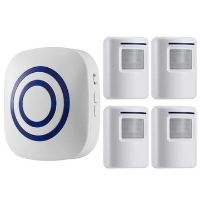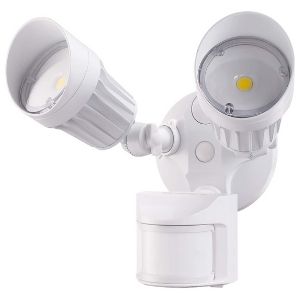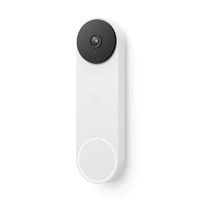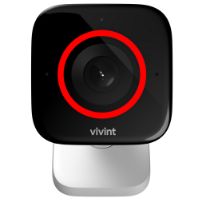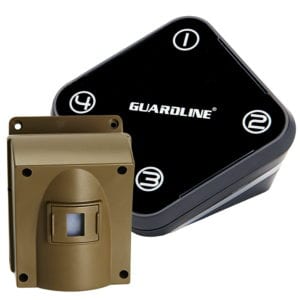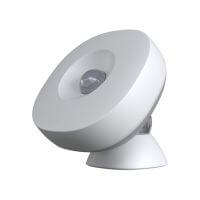Every motion sensor in your home is like an extra set of eyes watching the places you can’t see, so it’s important to make sure each sensor has a clear line of sight. We’ll give you a brief overview of how motion detectors work and a few tips on where to position motion sensors in the home like a pro.
How to Effectively Place Motion Sensors in Your Home
SafeWise experts have years of firsthand experience testing the products we recommend. Learn how we test and review.
Video: Where Should You Install Motion Sensors?
Subscribe to our YouTube channel and learn how to protect your home, loved ones, and belongings.
How Motion Sensors Work
The most common type of motion sensor used in home security is a passive infrared sensor, otherwise known as a PIR sensor. PIR sensors send out rays designed to detect heat. The sensor’s rays fan out, so they’re most concentrated right next to the sensor, and become less sensitive farther away from the sensor. The rays can’t detect heat through walls or furniture, so it's important to place these sensors where the rays are clear of obstacles.
Less common are microwave sensors, ultrasonic sensors, vibration sensors, and area reflective type sensors. Dual technology sensors combine PIR technology and microwave technology for fewer false alarms. To learn more about how motion sensors work and the role they play in a home security system, read our Beginner's Guide to Motion Sensors.
Good Placement Options
*Amazon.com price as of post date. Offers and availability may vary by location and are subject to change. Read full disclaimer.
Selecting the best place to install motion sensors will allow you to cover a larger area with fewer sensors, saving you time and money.
High Traffic Areas
You know those areas of your home where the flooring gets worn down the most because everyone walks through them? Those are great locations for motion sensors because an intruder will have to walk through those spots as well.
Corners
Imagine you’re trying to get a good photograph of a large room. Where would you stand to take it? Yup, a corner. The same location that gives you the widest view of a room will give your sensor a good view of the room as well.
Six to Eight Feet Up
You want your motion detector to get a birds-eye view of the space, but placing it too high can lead to blind spots down low. Six to eight feet up on the wall is the sweet spot for most motion sensors. You can put a motion sensor on the ceiling, but first make sure it has a full 360-degree viewing angle.
Over a Doorway
You know how pranksters like to position buckets of water over doorways to drop on unsuspecting victims? You can use that same technique to keep your motion sensors out of intruders’ sight by placing them just over an exterior door inside your home. They won’t know it’s there until it’s already sounded an alarm.
Basements
Basement windows and doors are prime entry points for intruders who want to stay off your radar. Motion sensors work great in basements because most basements have wide spaces with few barriers and they don’t heat up like garages do.
Basements are also a good spot for flood sensors. A flood sensor can detect moisture on the floor and sound an alarm to alert you to flooding before too much damage happens.
Behind Your Valuables
Catch thieves red-handed by placing motion sensors behind valuables. This makes the sensor blind to movement unless the crook moves the object and reveals themselves to the motion sensor, triggering an alarm.
Poor Placement Options
Putting your active sensors in the wrong location can lead to blind spots and false alarms. Here are a few sensor locations to avoid.
Behind Large Furniture
Think of your infrared motion detection beam like a flashlight beam. If you place it above a piece of tall furniture that sticks out far from the wall, the furniture could create a “shadow” or a blind spot. Avoid putting motion sensors on a wall near the top of a bulky entertainment center, wardrobe, or other large piece of furniture.
Near a Heat Source
Motion sensor infrared works by detecting sudden changes in temperature. Putting a motion sensor near a heating vent, radiator, oven, light fixture, or anywhere else likely to have a sudden increase in temperature is a recipe for false alarms.
Most modern windows are insulated enough to block sudden temperature changes from direct sunlight, but if you have older windows, you should avoid placing sensors where they could heat up from the sun.
Garages, Attics, Patios, and Sunrooms
Again, motion sensors use their infrared beams for high temperature detection, so it’s a good idea to avoid putting them in non-climate-controlled spaces that might heat up, like garages, attics, patios, and sunrooms. Consider alternative security solutions for these spaces, like door and window sensors, glass break sensors, or a security camera.
Stairs
If you have pets and you don’t want your motion sensors to get triggered by your dog or cat, avoid putting sensors at the top of stairs. As your pet climbs the stairs, it will look bigger to the motion detector and it could set off an alarm.
Across from Doors
While it’s a good rule of thumb to avoid putting motion sensors across from doors, it’s really dependent on your home’s layout. Remember that PIR sensors can’t see through walls, so you may be limiting a sensor’s detection scope if you put it directly across from a doorway in a confined area.
More Ways to Use Motion Sensors
It’s easy to think of a motion sensor as a standalone home security device to guard against intruders, but pairing motion detection technology with other smart tech can help you save on energy bills, keep family members safe, and streamline your life.
Motion Sensor Lighting
*Amazon.com price as of post date. Offers and availability may vary by location and are subject to change. Read full disclaimer.
Place motion sensing flood lights outside just under your eaves or near a garage door for added security. You might also consider positioning outdoor lights with motion sensors along pathways to help you see better in the dark. If you want night lights for outdoor walkways, look for solar lights to keep energy costs even lower.
Use motion-sensing lights in rooms like bathrooms and laundry rooms where lights frequently get left on and forgotten. Since they’ll turn on only when someone is in the room, motion sensor lights can help you save a ton of money on your monthly electricity bill.
Motion Sensors for Restricted Areas
If there are areas of your home you’d like to keep off-limits to kids, pets, or aging family members, let motion sensors do the work for you. A well-placed motion sensor can alert you to movement in an off-limits area when you’re not home. When you are home, you can disarm the sensor.
Video Cameras
Info current as of post date. Offers and availability may vary by location and are subject to change.
Most smart video doorbells use motion-sensing technology to detect when someone is at your front door.
Info current as of post date. Offers and availability may vary by location and are subject to change.
Outdoor and indoor cameras also incorporate motion sensors to generate motion-triggered recordings. Using motion sensors helps you save the battery life on your camera by limiting camera recordings to significant events.
Professionally monitored systems like Vivint home security, have a Smart Sentry feature on all of their cameras which makes a loud chime when it senses movement to scare would-be burglars from your yard. Vivint security cameras are available as part of a complete home security system and include professional installation.
Driveway Alerts
Amazon.com price as of post date. Offers and availability may vary by location and are subject to change. Read full disclaimer.
If you live in a rural area with a long driveway, driveway sensors can alert you to visitors before they arrive on your doorstep. Be sure to use an all-weather motion detector that’s been designed for outdoor use.
Smart Motion Sensors
Amazon.com price as of post date. Offers and availability may vary by location and are subject to change. Read full disclaimer.
Some standalone motion detectors, like the Samsung Smartthings Motion Sensor, can be used for a variety of purposes when connected to a hub like the Smartthings Hub. You can create scenes with specific conditions, like, “When motion is detected in the upstairs hallway between 6 a.m. and 6:30 a.m., start coffee pot.” You can also link motion sensors with smart plugs to control lighting or connect them to your security system.
Compare the best home security systems
Info current as of post date. Offers and availability may vary by location and are subject to change. Read full disclaimer.
Full ADT disclaimer
Related Pages on SafeWise
Disclaimer
Product prices and availability are accurate as of post date and are subject to change. Any price and availability information displayed on Amazon at the time of purchase will apply to the purchase of this product. Safewise.com utilizes paid Amazon links.
Certain content that appears on this site comes from Amazon. This content is provided “as is” and is subject to change or removal at any time.
Google, Google Nest Secure, [any other related Google Products] and other related marks are trademarks of Google LLC.
Recent Articles




